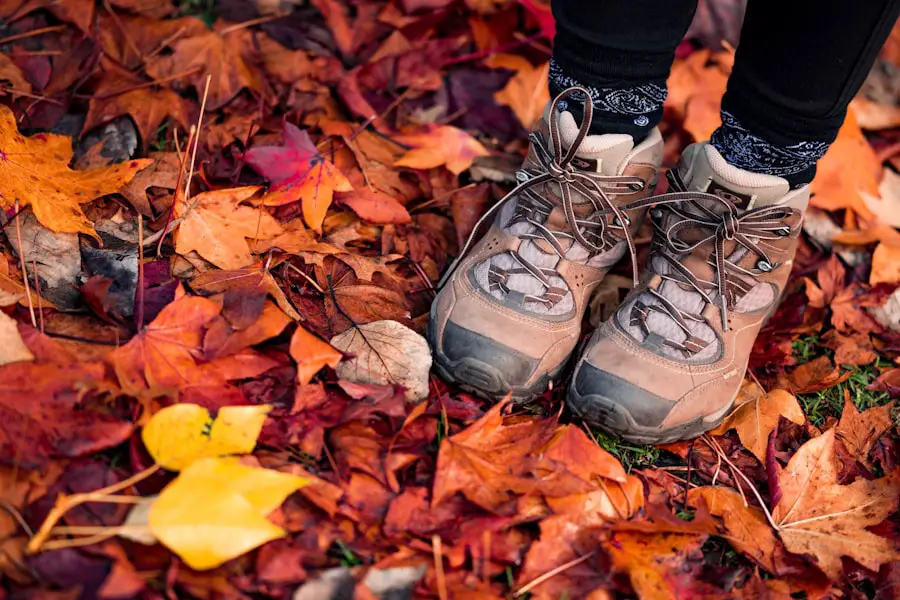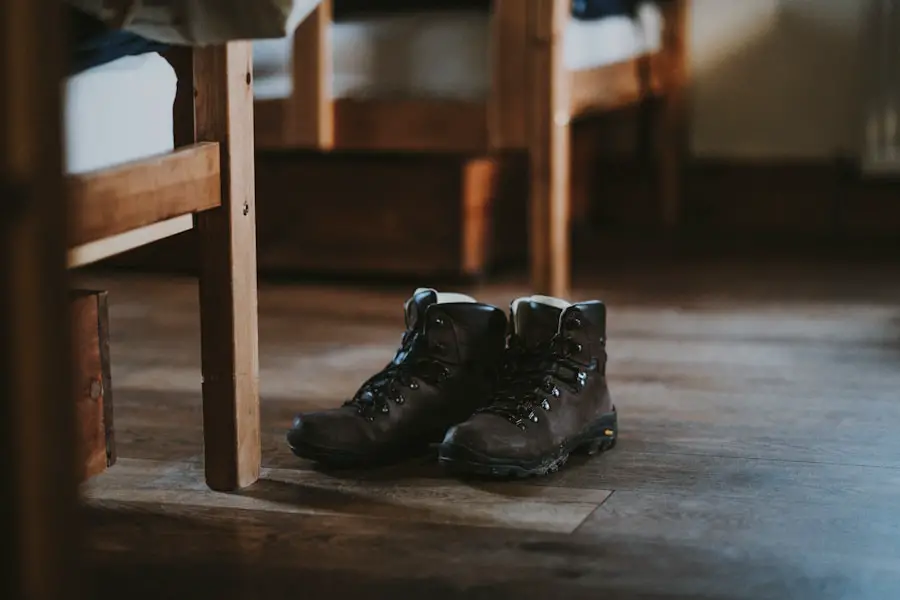Building hiking stamina is crucial for anyone who wishes to explore the great outdoors, whether for leisure or as a serious pursuit. Stamina, in this context, refers to the ability to sustain prolonged physical activity, which is essential when traversing varied terrains and enduring long distances. Hiking often involves steep ascents, uneven ground, and changing weather conditions, all of which can challenge even the most seasoned adventurers.
Without adequate stamina, hikers may find themselves fatigued, unable to enjoy the experience fully, or worse, at risk of injury due to overexertion. Moreover, developing hiking stamina is not just about physical endurance; it also enhances the overall hiking experience. When hikers are physically prepared, they can focus on the beauty of their surroundings rather than the discomfort of fatigue.
This mental clarity allows for a deeper connection with nature, fostering a sense of accomplishment and well-being. Additionally, improved stamina can lead to longer hikes and the ability to tackle more challenging trails, opening up a world of exploration that might otherwise remain inaccessible.
Key Takeaways
- Building hiking stamina is important for enjoying longer and more challenging hikes
- Proper nutrition, including a balance of carbohydrates, protein, and healthy fats, is essential for hiking endurance
- Training and conditioning, including cardiovascular and strength exercises, are key for improving hiking stamina
- Investing in quality gear and equipment, such as hiking boots and backpacks, can improve hiking stamina
- Utilizing proper breathing techniques and mental strategies can help improve hiking endurance and stamina
Proper Nutrition for Hiking Endurance
Nutrition plays a pivotal role in building and maintaining hiking stamina. The body requires a balanced intake of macronutrients—carbohydrates, proteins, and fats—to fuel extended physical activity. Carbohydrates are particularly important as they provide the primary source of energy during aerobic activities like hiking.
Foods such as whole grains, fruits, and vegetables should be staples in a hiker’s diet leading up to and during hikes. These foods not only supply energy but also contain essential vitamins and minerals that support overall health. In addition to carbohydrates, protein is vital for muscle repair and recovery.
Consuming adequate protein before and after hikes can help mitigate muscle soreness and promote faster recovery times. Lean meats, legumes, nuts, and dairy products are excellent sources of protein that can be easily incorporated into meals or snacks. Furthermore, healthy fats from sources like avocados, olive oil, and nuts provide sustained energy for longer hikes.
A well-rounded diet that emphasizes these macronutrients will ensure that hikers have the energy reserves needed to tackle challenging trails.
Training and Conditioning for Hiking Stamina

To build hiking stamina effectively, a structured training regimen is essential. This training should include a combination of cardiovascular exercises, strength training, and flexibility work. Cardiovascular activities such as running, cycling, or swimming can significantly enhance aerobic capacity, allowing hikers to sustain longer periods of exertion without fatigue.
Incorporating interval training—alternating between high-intensity bursts and lower-intensity recovery periods—can also improve cardiovascular efficiency. Strength training is equally important for hiking stamina. Focusing on core strength and leg muscles will not only improve endurance but also enhance balance and stability on uneven terrain.
Exercises such as squats, lunges, and deadlifts can build the necessary muscle groups used during hiking. Additionally, incorporating exercises that target the upper body can help with carrying a backpack over long distances. Flexibility training through yoga or stretching routines can prevent injuries by improving range of motion and reducing muscle tightness.
Gear and Equipment to Improve Hiking Stamina
| Gear and Equipment | Benefits |
|---|---|
| Quality Hiking Boots | Provides ankle support and reduces fatigue |
| Moisture-Wicking Clothing | Keeps you dry and comfortable during long hikes |
| Trekking Poles | Reduces strain on knees and improves stability |
| Hydration Pack | Ensures easy access to water to stay hydrated |
| Backpack with Hip Belt | Distributes weight evenly and reduces back strain |
The right gear can significantly impact a hiker’s stamina and overall experience on the trail. Footwear is perhaps the most critical piece of equipment; well-fitted hiking boots or shoes provide support and traction while minimizing the risk of blisters and discomfort. Investing in high-quality footwear designed for specific terrains can make a substantial difference in how one feels during long hikes.
In addition to footwear, carrying an appropriately sized backpack is essential for maintaining stamina. A well-designed pack distributes weight evenly across the body, reducing strain on the back and shoulders. It should also have features such as adjustable straps and ventilation to enhance comfort during extended use.
Furthermore, utilizing trekking poles can help distribute weight and reduce impact on joints, particularly during descents. These tools not only improve physical endurance but also contribute to a more enjoyable hiking experience by allowing hikers to focus on their surroundings rather than discomfort.
Breathing Techniques for Hiking Stamina
Breathing techniques play a crucial role in enhancing hiking stamina by optimizing oxygen intake and improving overall efficiency during physical exertion. One effective method is diaphragmatic breathing, which involves engaging the diaphragm rather than shallow chest breathing. This technique allows for deeper breaths that increase oxygen supply to the muscles, thereby enhancing endurance.
Practicing this method during training can help hikers develop a natural rhythm that they can rely on during strenuous hikes. Another beneficial technique is rhythmic breathing, where hikers synchronize their breath with their steps. For instance, inhaling for three steps and exhaling for two can create a steady flow of oxygen while maintaining a consistent pace.
This method not only aids in stamina but also helps regulate heart rate and reduce feelings of fatigue. By incorporating these breathing techniques into their routine, hikers can improve their performance on the trail and enjoy longer excursions with greater ease.
Mental Strategies for Building Hiking Endurance

Mental fortitude is as important as physical preparation when it comes to building hiking endurance. Developing a positive mindset can significantly influence how one perceives challenges on the trail. Visualization techniques can be particularly effective; by imagining oneself successfully completing a hike or overcoming obstacles along the way, hikers can boost their confidence and motivation.
This mental rehearsal prepares them for real-life scenarios where they may face fatigue or self-doubt. Additionally, setting achievable goals can help maintain focus and motivation during hikes. Breaking down long trails into smaller segments allows hikers to celebrate small victories along the way, making the overall journey feel less daunting.
Practicing mindfulness while hiking—focusing on the present moment rather than worrying about distance or fatigue—can also enhance enjoyment and reduce stress levels. By cultivating these mental strategies, hikers can build resilience that complements their physical training.
Hydration for Hiking Stamina
Hydration is a critical component of maintaining stamina during hikes. The body loses fluids through sweat and respiration, especially during prolonged physical activity in warm weather or at high altitudes. Dehydration can lead to fatigue, decreased performance, and even serious health issues such as heat exhaustion or heat stroke.
Therefore, it is essential for hikers to drink water regularly before, during, and after their hikes. To optimize hydration strategies, hikers should aim to consume water consistently rather than waiting until they feel thirsty. Carrying a hydration system—such as a water bladder or bottles—ensures easy access to fluids throughout the hike.
In addition to plain water, electrolyte-rich drinks can be beneficial during long hikes or in hot conditions to replenish lost minerals like sodium and potassium. Monitoring urine color can also serve as an indicator of hydration status; pale yellow typically indicates adequate hydration while darker shades suggest a need for more fluids.
Recovery and Rest for Hiking Endurance
Recovery is an often-overlooked aspect of building hiking stamina but is essential for long-term endurance development. After strenuous hikes or training sessions, allowing time for muscles to recover is crucial in preventing injuries and promoting growth. Active recovery methods such as light walking or gentle stretching can help alleviate soreness while maintaining blood flow to the muscles.
Incorporating rest days into a training schedule is equally important; these days allow the body to repair itself and adapt to increased physical demands. Quality sleep also plays a vital role in recovery; during sleep, the body undergoes various restorative processes that are essential for muscle repair and overall health.
If you’re looking to increase your stamina for hiking, you may also be interested in checking out this article on the best travel fishing rods. Having the right equipment for fishing while on your hiking trip can help you relax and unwind after a long day of trekking. Additionally, you may want to consider investing in a travel scooter to help you navigate rough terrain more easily. And don’t forget to pack one of these portable phone chargers to ensure you stay connected while on the trails.
FAQs
What is stamina and why is it important for hiking?
Stamina refers to the ability to sustain prolonged physical or mental effort. It is important for hiking as it allows hikers to endure long distances and challenging terrains without feeling fatigued.
How can I increase my stamina for hiking?
To increase stamina for hiking, you can engage in regular cardiovascular exercises such as running, cycling, and swimming. Additionally, incorporating strength training and hiking-specific workouts into your routine can also help improve your stamina.
What are some dietary tips to improve stamina for hiking?
Eating a well-balanced diet that includes complex carbohydrates, lean proteins, and healthy fats can help improve stamina for hiking. It is also important to stay hydrated and consume sufficient electrolytes to support endurance during hikes.
How does proper rest and recovery contribute to increased stamina for hiking?
Proper rest and recovery are essential for increasing stamina for hiking as they allow the body to repair and strengthen muscles. Adequate sleep, rest days, and stretching can help prevent fatigue and improve overall endurance.
Are there any specific hiking techniques that can help improve stamina?
Practicing proper hiking techniques such as maintaining a steady pace, using trekking poles for support, and taking regular breaks can help improve stamina during hikes. Additionally, focusing on breathing techniques and maintaining good posture can also contribute to increased endurance.
